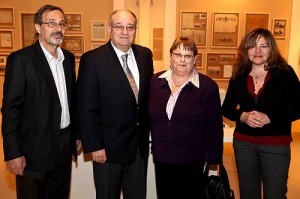Events marking Technion’s Centennial Have Begun
 Exhibition of the Founding of the Technion and the War of the Languages that was part of it has opened at the Haifa City Museum
Exhibition of the Founding of the Technion and the War of the Languages that was part of it has opened at the Haifa City Museum
The founding of the Technion was a defining cultural event for the Jewish settlement in the Land of Israel at that time, hugely important for the city of Haifa and later on – made an inestimable contribution to the state of Israel in all fields, and especially in the area of infrastructure, defense and economics.
The exhibition’s curator, Sventlana Reingold, said that she is coming to tell the story of the Technion’s founding, which took more than fifteen years, from 1908-1924. During this period, a battle over the teaching language in the institution, dubbed the “War of the Languages,” raged.
The “war” finished with the victory of the Hebrew language. This was a “war” of the people that shaped the national identity of the Hebrew settlement and was one of the milestones in the process of creating a new Hebrew culture.
The exhibition presents an important and significant part of the process of building Israeli culture, by showing the different positions driving the processes that produced the victory of the Hebrew language: formulization of the idea for establishing a technological-scientific institution in the land of Israel by the “Aid Association of German Jews” in Berlin; the Zionist educational perspective; selecting the site of the “Technikum”; the viewpoint of Alexander Baerwald – the architect who translated the vision into architectural language and designed the magnificent building on the slopes of the Carmel; the “War of the Languages” and its implications for the teaching language of the Reali School and of the “Technikum”; the move of the “Technikum” to nearby the Zionist Agency and the opening of its doors in 1924.
The exhibition has hundreds of photographs, films, books, models, documents, letters and rare collection items that are being shown to the public for the first time.
At the opening ceremony Nisim Tal, general manager of the Haifa museums, said that the exhibition was also inaugurating a new hall in the Templar school, which had been added to the Templar Assembly Hall, as part of the Haifa City Museums. He stressed that in all of the Ottoman Empire of that period, when the Technion was founded, there was not even one technological university worthy of its name.
Ms. Hedva Almog said that the exhibition brings to light a fundamental and valuable subject of concern for us in Israel – the subject of the Hebrew language. “Happily for us, the ‘battle’ about the Technion’s teaching language was decided a hundred years ago, but the war of the Hebrew language continues to this very day,” she added. “The language of today sounds like gibberish – a mixture of sounds that sometimes, for someone listening from the side, seems to be sounds that have no connection to each other.”
Technion president, Prof. Peretz Lavie, said that even the giants that envisioned the founding of the Technion more than a hundred years ago, did not dare dream that the Technion would be a world leading technological-scientific university, from which two Noble prize winners for chemistry, Professors Avraham Hershko and Aaron Ciechanower, would emerge, in which the anti-Parkinson drug Azilect would be developed by Professors Moussa Youdim and John Fineberg, whose researchers would make decisive contributions to such important fields and whose graduates would contribute so much to the defense and economic resilience of the state of Israel.
Above (from right to left): The curator, Svetlana Reingold, Hedva Almog, Prof. Peretz Lavie and Nisim Tal. Photograph: Yossi Carasso.


